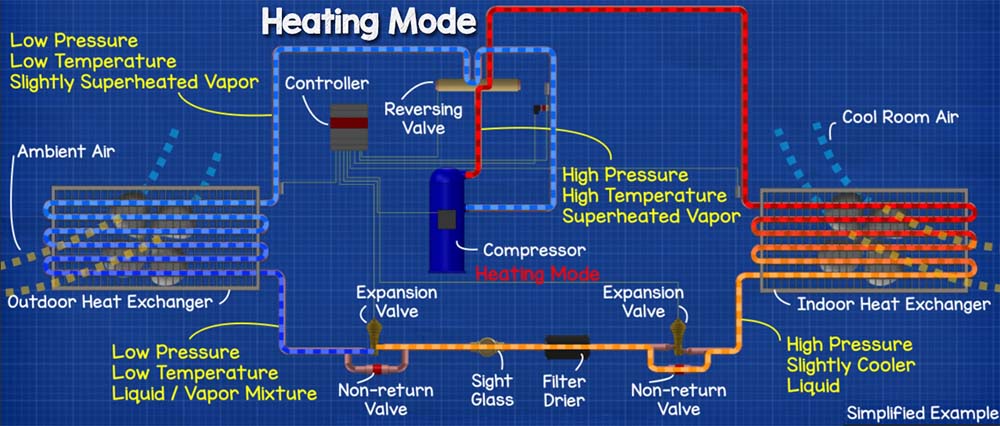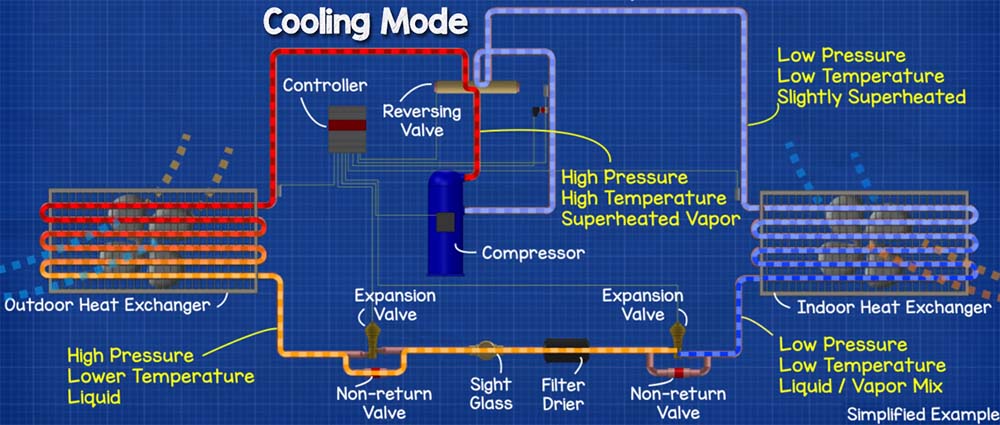Air source heat pumps have been around for some time and they’re growing in popularity. These units can be used to provide both heating in the winter months and cooling in the summer. Visually, they will often be indistinguishable from a conventional split air conditioning unit with the system split into two parts. One part of the system is installed externally and the other part is installed within the property. It’s only when you see inside the unit you can really tell the difference.
Conventional split air conditioning unit
Consider a conventional air conditioning unit, which provides cooling only. This system will have an indoor unit, known as the evaporator, mounted inside the property, which collects the unwanted heat and uses a small fan to blow cooler air across the room. There will also be an external unit, known as the condenser, which rejects the collected unwanted heat into the outside ambient air. The unwanted heat is transported from the evaporator and over to the condenser via a refrigerant, which is constantly flowing in some pipes between the two units, pushed around the system by the compressor.
The refrigerant changes state between a liquid and a gas, as well as pressure and temperature as it flows around the system; this allows it to pick up and drop off unwanted heat. When it leaves the compressor, it will be a high-pressure, high-temperature, superheated vapor; this enters the condenser and, as the name suggests, the refrigerant will condense into a liquid. As it condenses, it gives up the unwanted heat to the outside ambient air. This is transferred through the heat exchanger wall, and the outside air and the refrigerant never come into direct contact with each other.
The liquid state refrigerant, which is still high pressure, then flows to the expansion valve and expands into a low-pressure, low-temperature part-liquid part-vapor mixture. Much like when you push the cap down on a spray paint can, the nozzle will release a mist of liquid and gas: the pressure is high inside the can and low as it exits the nozzle. This mixed state refrigerant flows through the tubes of the heat exchanger, within the evaporator, inside the property.
Refrigerants have an extremely low boiling point. Water boils at 100°C (212°F) but a refrigerant such as R410A has a boiling point of -48.5°C (-55°F), which means it’s incredibly easy to change from a liquid to a vapor.
As the refrigerant passes through the evaporator, the heat of the room will cause the refrigerant to boil and evaporate. As it evaporates it will pick up the heat of the room and carry this away around the system. Much like when you heat a pan of water, the water evaporates and carries the heat away as steam.
This low-pressure, low-temperature, slightly superheated vapor flows back to the compressor, which will pack the refrigerant, containing the unwanted heat, into a smaller volume. This compression will increase the temperature and pressure. We need the temperature of the refrigerant to increase so that when it passes through the condenser it is hotter than the outside ambient air; this temperature difference allows the heat to leave the system. The greater the temperature difference, the easier it is to reject and transfer heat. We need the pressure difference to push the refrigerant around the system.
The difference between this conventional system and a heat pump is that the heat pump can provide heating by reversing its operation to move heat from the outside ambient air into the property, even on a cold day. Essentially it’s an air conditioning unit working in reverse.
To do this, the system contains a reversing valve, an additional expansion valve, as well as some non-return valves to control the direction of flow. This allows the refrigerant to change direction and the condenser and evaporator to swap roles.
Heating mode
In heating mode, the refrigerant leaves the compressor as a superheated vapor, enters the reversing valve, and is diverted straight to the indoor unit to push heat into the space. This indoor unit is now the condenser, so the refrigerant gives up its heat to the indoor air and then condenses into a liquid. After this it flows towards the outdoor unit, as it does so it passes through a non-return valve to bypass the cooling mode expansion valve. It then reaches another non-return valve, which is now closed. The refrigerant will pass through the heating mode expansion valve, where it’s expanded into a mixed vapor/liquid state. This flows into the outdoor unit, which is acting as the evaporator.
As long as the outside ambient air is above the boiling point of the refrigerant, thermal energy can be extracted from the air. Although it becomes increasingly difficult, and therefore less efficient, to collect thermal energy from the outside air the lower the air temperature becomes. At some point the compressor’s electrical consumption is greater than the heat output of the unit. This isn’t a concern for a typical installation though; the units are designed and tested to specified standard conditions with minimum efficiency stipulated by government regulations.
As the refrigerant flows through the outdoor unit, the temperature of the outside ambient air will cause the refrigerant to boil. This picks up thermal energy and it will flow to the compressor. The compressor compacts this into a smaller volume to increase the temperature and pressure and then pushes this into the property to provide heating.

Click diagram to expand

Cooling mode
In cooling mode, the system works as a conventional air conditioning unit with the compressor pushing a high-pressure, high-temperature superheated refrigerant out and into the reversing valve. The reversing valve diverts this to the outdoor unit, which condenses the refrigerant into a high-pressure, slightly cooler liquid and this will then flow through a non-return valve to bypass the heating mode expansion valve, and then flows into the cooling mode expansion valve.
The refrigerant expands into a low-pressure, low-temperature, liquid/vapor mixture and flows into the indoor unit. The indoor air will cause it to evaporate and boil, the refrigerant then takes this heat and heads back to the compressor as a low-pressure, low-temperature, slightly superheated vapor where the cycle repeats.

Click diagram to expand






